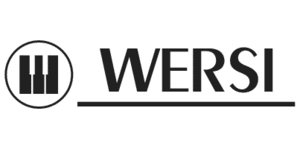
Wersi is a Sino-German electric organ, keyboard and piano manufacturer (it was named after German towns Werlau and Simmern). Franz Lambert, Klaus Wunderlich and Jimmy Smith used to play the company’s organs.
Modern instruments of the brand are based on Open Architecture System (OAS) – graphic interface for Windows allowing the keyboard to interact with third-party software (such as soft variants of some synthesizers or virtual studios).
The story of Wersi began in Germany in 1969.
In the 1970s the company established production and trade of the kits which allowed users to build instruments on their own making it for them cheaper than selling an assembled unit.
In the mid-70s famous German organ players Franz Lambert and Klaus Wunderlich preferred Wersi to other brands using the instruments in their recordings and taking them in tour.
In the 1980s the company launched the line of digital instruments – CD-Line. Spectra and Helios presented at Musikmesse in 1987 are considered to be the most commercially successful Wersi keyboards.
In the 1980s two huge factories were built in Halsenbach – the hometown of the company’s founders. The big concert hall, offices, research and development laboratories, workshop, ironworks and painting factory are still functioning there though there’s enough of space for other companies as well. Reinhard Franz, one of the brothers who founded the company, supervised the whole process.
In the 1990s Wersi created Garnd Piano digital series as well as digital instruments based on sampling and such innovations as: Livestyle upgrade for CD-Line, Golden Gate, PhonX, Performer and Pegasus (Pegasus became the first keyboard in the world featuring touch screen).
In the end of the 90s Wersi designed OX7 module and started to work on Open Art System new generation instruments. The company opposed OAS system (allowing you to make your instrument open for modernization) to many organs each of which had only 1-2 updates more than the predecessor using the circuitry with fixed tasks for tone-generation and other functions. Thanks to OAS Wersi organs became the first models ensuring an easy access to software updating.
Virtual Physical Tone Generation is responsible for Wersi sound quality – it allows accurate imitating of mechanical, analog or digital organs, successful reproduction of a 2-chamber rotary acoustic system and Advanced Sound System. The tone-generator uses up to 5 various sound producing technologies.
In 2010 Wersi was acquired by European musical distribution company, Music Store Professional as an official distributor and Chinese instruments manufacturer called Medeli. The new instrument Pegasus Wing was demonstrated at Musikmesse in April, 2011. The event gave the world the new Wersi keyboard line made by Chinese company Medeli.
Pegasus Wing allows you to split a velocity sensitive semi-weighted 76-note keyboard into 4 voices to the right part and 3 voices to the left one; you can also connect a MIDI keyboard applying it as a lower manual. Among Pegasus Wing specs we should mention: 10″ TFT ColorTouch Screen, 100 factory presets and 500 user ones, 2 drawbar sets, 950 sounds, 450 styles and live recorded drums.
Besides, Wersi produces Louvre, Scala GS 700, Sonic and Verona GS 500 instruments.
Louvre GS 1000 offers 3 keyboards, 25-note pedal keyboard and, of course, touch screen and OAS. Besides, there’s a brand standard Solid State Hard Drive, 1 GB RAM, 4 surround sound channels, 4 USB ports, vocal harmonizer, OX7 system (with B4 and VB3 possibilities), live drums, mixer inputs/outputs, MIDI editors, CD/DVD recording function, 950 sounds and 2000 user presets.
Scala instruments have a One Touch function allowing you to trigger all the desirable user settings with a press of a button.
Sonic features such abilities as Easy to Expert mode switch, unlimited polyphony (depends on the way you use it), 8 GB memory, 350 styles (including 150 drums), microphone preamp, 2 MIDI ins/outs, DVD/Blu-ray support, high speed Solid State Drive, full sound, style, Midi data, assignments processing, direct mp3 recording and etc.
The production takes place in Germany, the development – in Köln with the help of Music Store.

